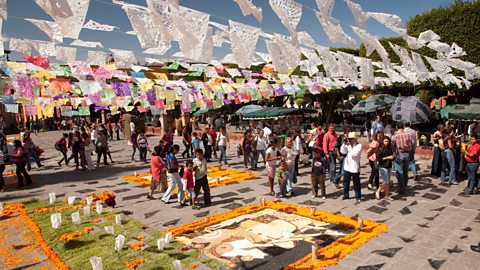Reading practice - popular Spanish festivals
Many traditions in Spain and Latin America have religious and cultural origins, but modern and international festivals are becoming more popular and new traditions are being created all the time.

Here is some useful vocabulary:
| el banquete | feast |
| el carnaval | carnival |
| el desfile | parade |
| el disfraz | fancy-dress costume |
| el entretenimento | entertainment |
| la máscara | mask |
| la procesi├│n | procession |
| el banquete |
| feast |
| el carnaval |
| carnival |
| el desfile |
| parade |
| el disfraz |
| fancy-dress costume |
| el entretenimento |
| entertainment |
| la máscara |
| mask |
| la procesi├│n |
| procession |
Read the following statements about different festivals in Spain and Spanish-speaking countries - some are more well-known than others.
El D├¡a de los Muertos es considerado una de las fiestas m├ís conocidas de la cultura mexicana. La celebraci├│n se lleva a cabo en dos d├¡as: el 1 de noviembre es dedicado al alma de los ni├▒os y el 2 de noviembre a la de los adultos. Hay bailes tradicionales, aut├®ntica comida y entretenimientos mexicanos.
El Carnaval de Tenerife se considera el segundo m├ís bello del mundo despu├®s del de R├¡o de Janeiro. Se encuentran disfraces, desfiles y m├║sica con ritmos latinos. Esta fiesta se celebra tres semanas despu├®s de Semana Santa y cada a├▒o se elige un tema diferente y se realiza un concurso para coronar a la reina del carnaval.
Sevilla es una ciudad muy especial, sobre todo durante la Feria de Abril. Sevilla se viste de color durante la feria para representar la esencia de esta ciudad y el espíritu alegre de su gente. Tras una semana de fiesta constante, la Feria concluye con un gran espectáculo de fuegos artificiales junto al río Guadalquivir.
El burro tiene su día de festejo (El festival del burro) en la localidad de San Antero durante las celebraciones de Semana Santa. Durante el desfile, es todo un espectáculo ver a los burros disfrazados, muchas veces como personajes reconocidos internacionalmente, concursando por ser el rey y la reina del año.
Question
Which festivals are these statements referring to?
- This week-long festival is colourful and lively and ends with a firework display.
- This festival represents the culture of its country and the celebrations last for two days.
- This festival sees processions and parades with animals dressed up as famous people.
- This festival has a different theme every year and is considered one of the best parties in the world.
- Feria de Abril
- El Día de los Muertos
- El festival del burro
- El Carnaval de Tenerife
Translation:
El Día de los Muertos is considered to be one of the most recognisable traditions of Mexican culture. The celebration takes place over two days: 1st November is dedicated to the souls of children and 2nd November to those of adults. There are traditional dances, authentic foods and Mexican entertainment.
El Carnaval de Tenerife is considered to be the second most beautiful in the world after Rio de Janeiro. You can find costumes, parades and music with Latin rhythms. This festival is celebrated three weeks after Easter and every year, a different theme is chosen and there is a competition to crown the carnival queen.
Seville is a very special city, especially during Feria de Abril. Seville is dressed in colour during the festival in order to represent the essence of this city and the cheerful spirit of its people. After a week of constant parties, the festival concludes with a big firework display next to the Guadalquivir river.
The donkey has its own festival day, El festival del burro, in the region of San Antero during Holy Week celebrations. During the parade, it's quite a spectacle to see the donkeys dressed up, often as famous people, competing to be the king and queen of the year.